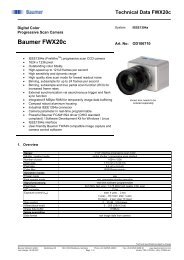Create successful ePaper yourself
Turn your PDF publications into a flip-book with our unique Google optimized e-Paper software.
<strong>Pantera</strong> <strong>SA</strong> DS -21-0<strong>2M30</strong> and DS-22-0<strong>2M30</strong> User’s Manual 42<br />
Illumination<br />
The amount and wavelengths of light required to capture useful images depend on the<br />
particular application. Factors include the nature, speed, and spectral characteristics of<br />
objects being imaged, exposure times, light source characteristics, environmental and<br />
acquisition system specifics, and more. DAL<strong>SA</strong>’s web site, http://vfm.dalsa.com/,<br />
provides an introduction to this potentially complicated issue. See “Radiometry and<br />
Photo Responsivity” and "Sensitivities in Photometric Units" in the CCD Technology<br />
Primer found under the Application Support link.<br />
It is often more important to consider exposure than illumination. The total amount of<br />
energy (which is related to the total number of photons reaching the sensor) is more<br />
important than the rate at which it arrives. For example, 5J/cm 2 can be achieved by<br />
exposing 5mW/cm 2 for 1ms just the same as exposing an intensity of 5W/cm 2 for 1s.<br />
Light Sources<br />
Keep these guidelines in mind when setting up your light source:<br />
• LED light sources are relatively inexpensive, provide a uniform field, and longer life<br />
span compared to other light sources. However, they also require a camera with<br />
excellent sensitivity, such as DAL<strong>SA</strong>’s <strong>2M30</strong> camera.<br />
• Halogen light sources generally provide very little blue relative to IR.<br />
• Fiber-optic light distribution systems generally transmit very little blue relative to IR.<br />
• Some light sources age; over their life span they produce less light. This aging may<br />
not be uniform—a light source may produce progressively less light in some areas of<br />
the spectrum but not others.<br />
Filters<br />
CCD cameras are extremely responsive to infrared (IR) wavelengths of light. To prevent<br />
infrared from distorting the images you scan, use a “hot mirror” or IR cutoff filter that<br />
transmits visible wavelengths but does not transmit wavelengths over 750nm. Examples<br />
are the Schneider Optics B+W 489, which includes a mounting ring, the CORION LS-<br />
750, which does not include a mounting ring, and the CORION HR-750 series hot<br />
mirror.<br />
Lens Modeling<br />
Any lens surrounded by air can be modeled for camera purposes using three primary<br />
points: the first and second principal points and the second focal point. The primary<br />
points for a lens should be available from the lens data sheet or from the lens<br />
manufacturer. Primed quantities denote characteristics of the image side of the lens. That<br />
is, h is the object height and h is the image height.<br />
The focal point is the point at which the image of an infinitely distant object is brought to<br />
focus. The effective focal length (f) is the distance from the second principal point to the<br />
second focal point. The back focal length (BFL) is the distance from the image side of the<br />
lens surface to the second focal point. The object distance (OD) is the distance from the first<br />
principal point to the object.<br />
DAL<strong>SA</strong> 03-32-10150-01
















